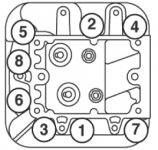Here this particular gasket design doesn't present itself as smoker most times here in my shop. I had one engine that burned one quart per 1/2 gallon of fuel and the only thing that was apparent while mowing was a smell of oil burning. Many modern oils don't smoke near as much as older oils did either. Most times the only indication of a blown head gasket is loss of oil volume and oil present in the air cleaner side of the carburetor. Now the fuel pump vent does sometimes have oil leaking out of it too.
Any engine using this particular gasket design that comes into my shop for the first time get a leak down test done to check the head gasket condition.
This particular head gasket design to prone to blowing between the cylinder and the push rod galley. While replacing head gasket make sure the head is not warped.
Also torque the head screws [bolts] to 20.8 fl/lbs [250 in/lbs] using three step torque method [1/3, 2/3, and Full] and in the proper torquing pattern [see below image]. This is the current torque specs for these gaskets and not what the chart says that is being passed around that specs 18.3 ft/lbs [220 in/lbs]. By going to 25 ft/lbs you risk aluminum thread pull out when the engine reaches full operating temperature. Also going to full torque all at once risks warping the head. Heads are not cheap. This head was $212 the last time I checked.
View attachment 59190
Valve clearance is .004-.006" for both intake and exhaust rockers. Rocker Jam Nut or set screw torqued 45 lb-in. Rocker cover screws [bolts] are torque to 65 in/lbs. Note some of these covers are mounted with RTV instead of a paper gasket. Both ways are acceptable. It just that RTV is less likely to leak when applied properly.
Personally I use the RTV method but I have the surface prep / accelerator chemical and know not to allow oil contact for at least 12 hrs. Also when the RTV is applied, screws are only tighten finger tight for at least 12 hrs, then the rocker cover is torque to final torque. I know it time consuming but it is what works here for leak proof application. The 30 minutes cure time on the product tube just don't work in a near airless application. Even at 12 hrs some uncured liquid squeeze out happens.

